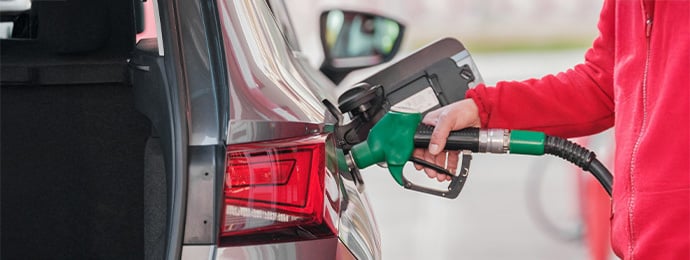
Fuel prices are making the headlines yet again, as prices increased in September according to RAC Fuel Watch. Google searches in the UK for “fuel prices” reached 116K searches over the past month, whilst searches for “cheap petrol” also increased by 48%.
As the cost of fuel is clearly still a concern for most drivers, and as we approach the festive season (an expensive time of year), we have written a blog to warn drivers of one key maintenance issue affected by cold winter weather that could end up costing UK drivers an extra £330 million if ignored.
In this blog, you’ll learn why tyre pressure matters, the extent of the problem, and what you can do to protect your wallet and stay safe. If you’re thinking of changing your car as well as your habits, you can explore car leasing deals from Nationwide Vehicle Contracts, which may offer lower running costs.

Fuel prices have risen steadily this autumn, and market uncertainty means drivers are feeling the strain. As the mercury drops, tyre pressure does too. For every 10 °C fall in temperature, pressure typically drops by 1–2 psi (7–14 kPa). Lower pressure means more of the tyre’s surface touches the road, increasing friction and rolling resistance. UK charity TyreSafe notes that just 6 psi below the recommended level can increase fuel consumption by 3 %. With cold weather causing pressure to drop naturally, a once‑a‑month tyre check is essential to avoid unnecessary fuel spending.
Underinflated tyres waste fuel because the engine has to work harder to overcome rolling resistance. There are several reasons for this:
- Greater contact patch: A soft tyre spreads out, increasing friction with the road surface and raising the force needed to turn the wheel.
- Extra deformation: As the tyre flexes, energy is lost as heat. This energy must be replaced by burning more fuel.
- Driver behaviour: A sluggish response makes drivers press the throttle harder, further raising fuel use.
Manufacturer Continental estimates that maintaining the correct tyre pressure alone can boost efficiency by up to 3%, while proper wheel alignment and tyre balance can add another 2%. In practice, a small pressure drop of 5–6 psi can result in a 3% reduction in miles per gallon. Either way, keeping tyres properly inflated is one of the simplest fuel‑saving measures you can take.
What 3 % means on the road: Assumes fuel prices of £1.354/L for petrol and £1.431/L for diesel:
Fuel Type | Distance Driven (4 Months) | Baseline Consumption | Extra Fuel At 3% | Extra Cost Per Car |
|---|---|---|---|---|
Petrol | 2,520 miles | 63 imp gal (286 L) | 8.6 L | £11.63 |
Diesel | 2,520 miles | 50.4 imp gal (229 L) | 6.9 L | £9.84 |
For an individual driver, the extra cost might seem modest. But scale it up across millions of vehicles and the numbers add up fast.
“Using current fuel prices of £1.35 per litre for petrol and £1.43 per litre for diesel, an average petrol car travelling 630 miles per month over four months could burn an extra 8.6 litres of fuel, costing around £11.60. Diesel drivers covering the same distance would use around 6.9 litres more, adding roughly £9.80 to their bills.
Individually, these amounts may not seem significant, but when scaled across the UK’s 19.3 million petrol and 11 million diesel vehicles, the collective extra cost reaches a staggering £332.6 million. This shows how much money and fuel could be wasted due to underinflated tyres. An extra cost that is entirely preventable with regular tyre checks.
Motorists are urged to check their tyre pressures at least once a month and before long journeys. Keeping tyres properly inflated not only saves fuel and money but also improves safety and reduces tyre wear. With winter approaching, a simple tyre check could help UK drivers save hundreds of millions collectively.”

*Methodology: To estimate the extra cost of underinflated tyres for UK drivers over the winter months, we assumed an average car drives 630 miles per month over four months, with average fuel economies of 40 mpg (petrol) and 50 mpg (diesel). Fuel prices were taken as £1.354/litre for petrol and £1.431/litre for diesel, and underinflated tyres were assumed to increase fuel consumption by 3%. We calculated total fuel used over 2,520 miles, added 3% extra for underinflation, and multiplied by the fuel price to estimate the additional cost per car. Using the figures of 19.3 million petrol cars and 11 million diesel cars registered in the UK (mid-2024, NimbleFins, 2025), we extrapolated the collective extra cost to be £332.6 million across all affected vehicles.
With around 31 million cars on UK roads, even a small increase in fuel consumption has a big impact. Using the assumptions above (2,520 miles driven over winter, 3 % extra fuel and current fuel prices) we get the figures shown in the table. For petrol cars, the extra fuel equates to roughly £11.60 per car, and for diesels roughly £9.80. Multiply these by millions of vehicles and the collective cost exceeds £330 million over four winter months. TyreSafe has previously estimated that UK drivers lose over £600 million every year through underinflated tyres, and other analyses suggest it could be closer to £1 billion.
These costs are entirely avoidable. As tyres cool in winter, their pressure falls naturally. Checking and topping up your tyres at the start of each month prevents a small pressure drop from becoming a long‑term drain on your finances. Remember that colder mornings mean you should expect lower readings; adjust to the recommended pressures listed in your vehicle’s manual or on the door sill.

Fuel economy isn’t the only reason to maintain tyre pressure. Underinflated tyres wear out more quickly and can reduce tread life by around 10%. Softer tyres also heat up more, increasing the risk of a blow-out. Handling suffers too, cars feel less responsive when turning or braking. The National Tyres and Autocare notes that dangerous tyres contribute to around 5,000 convictions, 900 casualties and 160 deaths or serious injuries each year in the UK. Driving on illegal tyres can also lead to fines of up to £2,500 per tyre and invalidate your insurance.
From an environmental perspective, soft tyres increase CO₂ emissions because more fuel is burned. Properly inflated tyres help cut emissions and reduce particulate pollution from tyre wear. Regular maintenance therefore benefits both your wallet and the planet.
Tyre pressure should be checked at least once a month and before long journeys. Follow these steps:
- Find the correct pressure: Look in your vehicle handbook, the fuel filler flap or the door sill. Some cars list different pressures for front and rear tyres or when carrying heavy loads.
- Use an accurate gauge: Digital gauges are inexpensive and easy to use. Many fuel stations provide pumps, but keep a home gauge as backup.
- Check cold: Measure pressure when tyres haven’t been driven for at least two hours; this gives a true reading. Warm tyres can show higher pressure.
- Adjust for load: Increase pressure slightly if carrying passengers, luggage or towing a trailer. Your manual will specify the correct values.
- Recheck the spare and TPMS: If your car has a spare wheel, check it too. If equipped with a tyre pressure monitoring system (TPMS), remember it only warns of rapid changes; it doesn’t replace monthly checks.
Regular checks not only save fuel but also improve braking and cornering performance. Making this part of your monthly routine will reduce wear, improve safety and cut costs. Find out how Tyre and Alloy Wheel Insurance could help cover you against common damage and save you money by reading our straightforward guide today.
Correct tyre pressure is only one part of a wider maintenance strategy. Additional measures include:
- Wheel alignment and balancing: Misaligned wheels cause uneven wear and increased rolling resistance. Proper alignment can improve fuel economy by up to 2%.
- Tyre rotation: Rotating tyres every 5,000 – 10,000 km helps ensure even wear and better fuel efficiency.
- Low rolling‑resistance tyres: Choosing tyres rated A on the EU label can improve fuel economy by up to 9%.
- Driving habits: Gentle acceleration, maintaining a steady speed and anticipating traffic reduce fuel consumption and tyre wear.
- Load management: Remove unnecessary items from your boot and avoid roof boxes when not in use, weight and aerodynamic drag increase fuel burn.
Underinflated tyres might seem like a small issue, but over time they hit your wallet hard. Checking your pressures regularly can save fuel, extend tyre life, and keep your car handling as it should through the colder months. Simple maintenance really does make a difference.
If you want to stay on top of your vehicle’s upkeep, explore our vehicle maintenance guides for practical tips and advice. You can also learn more about replacing the tyres on a lease vehicle to understand your responsibilities as a lessee.
And if you’re thinking about lowering your running costs further, take a look at our latest hybrid and electric lease deals for vehicles designed to go the extra mile on efficiency.
Originally posted: 15th October 2025

